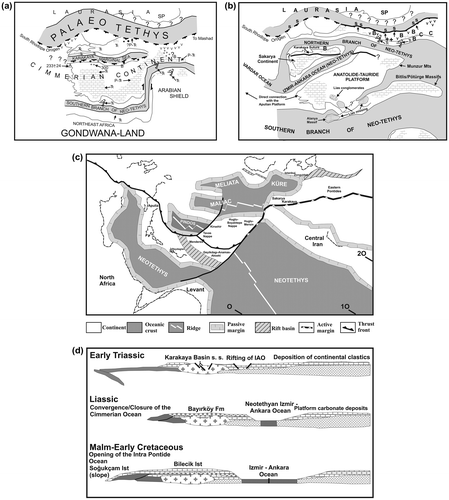Figures & data
Figure 1. (a) The main tectonic units in NW Turkey and the location of the study area. (b) Simplified geological map showing the structural units in the study area and its surroundings (modified after MTA, Citation2012). (c) Simplified structural section with the main tectonic slices along the southern Daday–Araç geotraverse the study area. Explanations are the same as Figure (b).
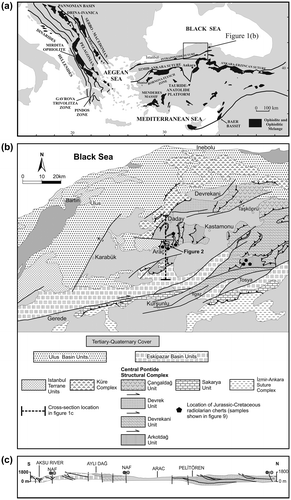
Figure 2. Local geological map of the Pelitören area with the location of the Middle and Late Triassic radiolarian chert block within the Arkotdağ mélange.

Figure 4. Field photographs from the Pelitören section: (a) Photographs showing the relation between first and second slices. Basic volcanics (BV) at the base of the section overlain by chert-mudstone alternations (CM) of the second slice with tectonic contact; (b) thin-bedded, red colored chert and silicified mudstone alternations where the sample 12-TC-303A was taken; (c–d) angular clasts derived from different lithologies (mainly chert) in clayey matrix, from where samples (12-TC-303D and 10-IPS-6) were collected; (e) photograph showing the locality of sample 12-TC-303H from highly deformed, gray to green colored, thin to medium-bedded, chert-mudstone (CM) alternations; and (f) tectonic relation between chert-mudstone alternations (CM) of late Early to early Middle Norian age and the overthrusting ophiolite body with an intervening amphibolite slice (UM) at the top of the section.

Figure 5. Scanning electron micrographs of the most critical Middle to Late Triassic radiolarians from the IntraPontide Suture Zone, northern Turkey. Scale number of microns for each figure: (a–h) Late Early to early Middle Carnian radiolarians from the sample 12-TC-303A in the Pelitören section: (a) Spongotortilispinus tortilis (Kozur & Mostler), scale bar- 100 μm; (b) Pseudostylosphaera nazarovi (Kozur and Mostler), scale bar- 125 μm; (c) Nodotetrasphaera cive (Sugiyama), scale bar- 100 μm; (d) Annulotriassocampe baldii Kozur, scale bar- 60 μm; (e) Annulotriassocampe sulovensis (Kozur & Mock), scale bar- 90 μm; (f) Canoptum cucurbita (Sugiyama), scale bar- 130 μm; (g) Canoptum levis Tekin, scale bar- 135 μm; (h) Canoptum inornatum Tekin, bar- 115 μm; (i–p) Early Late Carnian radiolarians from the sample 12-TC-303B in the Pelitören section: (i) Capnuchosphaera crassa Yeh, scale bar- 200 μm; (j) Capnuchosphaera mostleri Kozur, Moix & Ozsvart, scale bar- 150 μm; (k) Capnuchosphaera theloides De Wever, scale bar- 150 μm; (l) Capnuchosphaera tortuospinosa Kozur, Moix & Ozsvart, scale bar- 170 μm; (m) Weverella tetrabrachiata Kozur and Mostler, scale bar- 120 μm; (n) Spongotortilispinus tortilis (Kozur & Mostler), scale bar- 140 μm; (o) Spongotortilispinus carnicus (Kozur & Mostler), scale bar- 130 μm; (p) Pachus multinodosus Tekin, scale bar- 100 μm. (q–x) Late Early Ladinian radiolarians from the sample 12-TC-303D in the Pelitören section: (q–r) Paroertlispongus daofuensis Feng & Liang, scale bar for both specimens- 130 μm; (s) Pseudostylosphaera inaequata (Bragin), scale bar- 150 μm; (t) Pseudostylosphaera longispinosa Kozur & Mostler, scale bar- 275 μm; (u–v) Muelleritortis firma (Gorican), scale bar for both specimens- 125 μm; (w) Bulbocyrtium sp. scale bar- 115 μm; and (x) Triassocampe scalaris Dumitrica, Kozur & Mostler, scale bar- 100 μm.
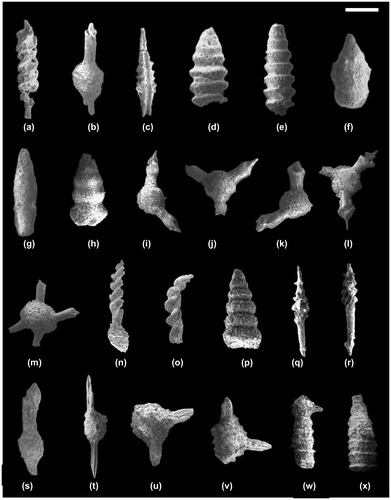
Figure 6. Stratigraphic ranges of the selected Triassic radiolarian taxa in the samples of the Pelitören section. Dark grey areas indicate the age of assemblages while light grey areas show the maximum ages of the assemblages.

Figure 7. Scanning electron micrographs of the most critical Middle to Late Triassic radiolarians from the IntraPontide Suture Zone, northern Turkey. Scale number of microns for each figure: (a–e) Late Anisian radiolarians from the sample 10-IPS-6 in the Pelitören section: (a–b) Paroertlispongus multispinosus Kozur & Mostler, scale bar for both specimens- 190 μm; (c) Paurinella trispinosa (Lahm), scale bar- 150 μm; (d) Tetrapaurinella tetrahedrica Kozur & Mostler, scale bar- 300 μm; (e) Pseudostylosphaera coccostyla acrior (Bragin), scale bar- 120 μm. (f–l) Late Early Norian radiolarians from the sample 12-TC-303F in the Pelitören section: (f) Capnodoce anapetes De Wever, scale bar- 140 μm; (g) Capnodoce sarisa De Wever, scale bar- 140 μm; (h) Capnuchosphaera theloides theloides De Wever, scale bar- 150 μm; (i) Xiphosphaera fistulata Carter, scale bar- 240 μm; (j) Syringocapsa turgida Blome, scale bar- 105 μm; (k) Pachus multinodosus Tekin, scale bar- 110 μm; (l) Japonocampe nova (Yao), scale bar- 100 μm. (m–t) Late Early to early Middle Norian radiolarians from the sample 12-TC-303G in the Pelitören section: (m) Capnodoce sarisa De Wever, scale bar- 150 μm; (n) Renzium adversum Blome, scale bar- 140 μm; (o) Nodocapnuchosphaera altineri Tekin, scale bar- 1890 μm; (p) Kinyrosphaera helicata goekcamensis Tekin, scale bar- 170 μm; (q) Palaeosaturnalis dumitricai Tekin, scale bar- 140 μm; (r) Xiphosphaera fistulata Carter, scale bar- 200 μm; (s) Syringocapsa batodes De Wever, scale bar- 115 μm; and (t) Whalenella sp., scale bar- 110 μm.
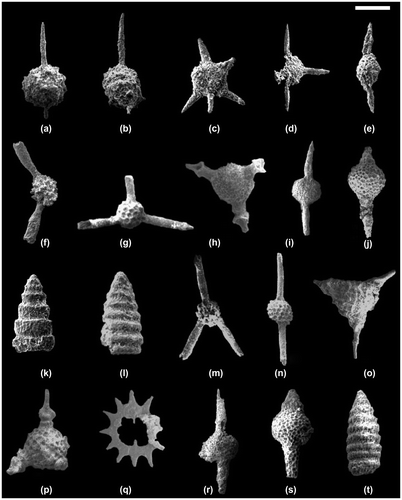
Figure 8. Radiolarian ages from IntraPontide Suture Zone: (1) Middle Bathonian-early Callovian age from sedimentary cover of the Aylı Dag Ophiolite sequence (Göncüoğlu et al., Citation2012) and late Kimmeridgian-early Tithonian age from slice in IPS (Göncüoğlu et al., Citation2008) (2) Radiolarian ages recently obtained in from IPS, ages shown with stripes indicate radiolarian ages illustrated in this study.
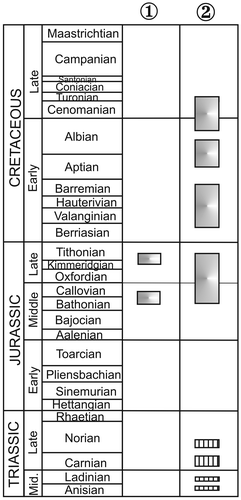
Figure 9. Jurassic and Cretaceous radiolarian findings from IPS suture zone. The sample locations are shown in Figure (b).
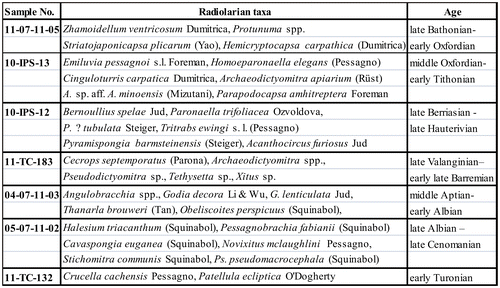
Figure 10. Sketches showing the distribution of the inferred Palaeo- and Neotethyan oceanic branches and terranes during the Triassic in SE Europe and NW Turkey. (a) (Permo-Triassic) and (b) (Early Jurassic): after Şengör and Yılmaz (Citation1981) and Şengör et al. (Citation1984), (c) Carnian paleogeography after Moix et al. (Citation2008). (d) Early Triassic-Early Cretaceous after Göncüoğlu et al. (Citation2000).
